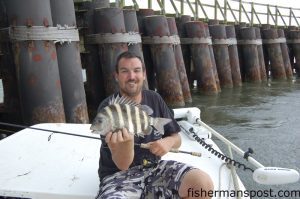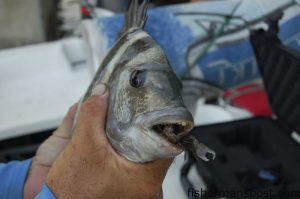Sheepshead Strike Twice

Capt. Phil Leonard, of East Coast Charters, and friend Jim Zilke with a sheepshead that struck a live, Carolina-rigged fiddler crab beside a concrete bridge support in Sneads Ferry.
“I really hate to run in here with the big motor,” Capt. Phil Leonard explained, angling his 21’ Clearwater Skiff into the current towards a nearby bridge bumper. “I think they even have to get used to the boat being here. They’ll come back and eat, but it takes a minute.”
“They” were sheepshead, at least we hoped. I’d reconnoitered with Phil, of Topsail’s East Coast Charters, and his buddy Jim Zilke earlier that afternoon, hoping to earn a little rod-bending action and a tasty meal or two with the striped crustacean-eaters. A rather violent thunderstorm had accompanied me through much of the journey north from Wilmington, giving me a bit of pause about heading out onto the water and waving a 7’ conductor around, but the skies cleared as I turned on to Hwy. 172 and made my way into Sneads Ferry.
Phil, Jim, and I holed up in Capt. Jim’s Restaurant for a while, eyeing clouds and smartphones in the hopes that the storm wasn’t marching our way, and after a few minutes, a hole in the yellow and red blobs on the radar screen materialized over the New River.
“Let’s go,” Phil urged, and the three of us scrambled out the door and to Phil’s skiff that was waiting in the water after a successful morning shark trip outside New River Inlet. “We might get wet on the way there, but I think the worst of it’s over.”
Both of those predictions turned out to be correct, but running through the drizzle only took the edge off yet another July day with temperatures nearing triple-digits. Ten minutes after we left the dock, Phil was maneuvering the skiff to the backside of the bumpers surrounding the New River’s channel under the 172 bridge.
After he and Jim secured the boat’s bow and stern to a pair of the rusty metal pilings, Phil began a quick fiddler-hooking demonstration for Jim and me.
“I see a lot of people go through the shell,” he explained, extending a purple and brown fiddler crab and a 1/0 wide gap hook in either hand. “I don’t believe in that. It makes them come off the hook easier. I just put the hook in the little soft spot right by their legs and leave the point inside the crab. Alright, y’all grab rods and have at it!”
I hastily followed Phil’s mandate, picking up a 7’ medium-action spinning rod and impaling my own fiddler on the business end of a short-leadered Carolina rig.
“Max, try that structure up in front of the boat,” Phil said, gesturing to a rusty steel piling a few feet off the bow, “where that piling angles out. I’ve caught a bunch there.”
I hopped on to the bow and began dropping my crab next to the askew piling, while Jim and Phil took the stern, fishing a concrete bridge support adjacent to another row of the rust-reddened steel pilings.
“Phil, should I be fishing on the bottom or dangling it along the piling?” I wondered aloud.
“Start out with it on the bottom,” he offered, “and work your way up the structure until you figure out where they’re at, and remember the depth if you start getting bites.”
I followed the strategy for a few minutes, but as the captain had suggested when we pulled up, the fish seemed to be off the feed.
“They don’t like that outboard,” Phil said after a few drops returned to the surface with crabs unmolested. “I had a guy break my trolling motor power wire yesterday, and I haven’t had time to replace it. Here, let me scrape the barnacles a little and see if that gets them feeding.”
Producing a clam rake from below the skiff’s gunnel, Phil used the tool to break free some barnacles from the pilings and concrete along the boat’s port side and stern.
“Million uses for a clam rake,” he continued. “This is like free chumming.”
I watched the barnacles and other attached material free-fall in the current, disappearing quickly into the New River’s tannin-stained water, and sent my Carolina-rigged crab down along with them.

The author with the day’s first sheepshead, hooked near a steel bumper piling beneath the 172 Bridge in Sneads Ferry while fishing with Capt. Phil Leonard of East Coast Charters.
It took a few minutes for the action to begin, but Phil and Jim both lost their fiddlers on the next drop, and mine came up crushed. Sheepshead are tricky fish to hook by any and all accounts, and I polled Phil for a little hookset advice after replacing my crab and reeling up an empty hook moments later.
“As soon as you feel anything, pop him!” he answered back, hooking a fresh crab of his own. “You’re going to feel two taps real quick. The first one is him sucking the crab in and smashing it, and the second is him spitting out the shell bits.”
I’d dropped another crab to the base of one of the steel pilings and slowly gotten it somewhere around halfway up when I felt the line move ever so slightly, less a bite than a whisper.
Reacting with a mighty jerk, I followed advice and “popped him.” I was pleased to feel a solid response from the other end, and the fish was whispering no more.
“Take him back away from the pilings!” Phil urged, hearing a slight burst of drag as the fish resisted being pried from its home structure. “They’ll go through there in a heartbeat and cut you off.”
I walked around the bow of the skiff, using the boat’s 7’ beam to put a little distance between the fish and its barnacle-encrusted home turf. Moments later, I pried the fish to the surface and swung it aboard, foolishly not waiting for Phil to slide a net beneath our striped quarry. Luckily, the hook held until the fish hit the deck, bouncing out of the spunky fish’s mouth as it thrashed out its displeasure with the situation against the fiberglass deck.
“See that?” Phil said, pointing at the fish. “When you pick up the rod, you can’t let any pressure off of him till he’s in the boat. Half the time when you net one, the hook falls out before you can get him out of the net.”
“You’re taking some home to eat, right?” he asked, to a heartily affirmative response. “Good. I’ll just put him in the livewell. These things are tough; they live forever in there.”
After a quick picture, in the well the fish went, and we were back to fishing.
Now, it seemed, the bite had turned on. Though I was feeling the brief nibble nearly every time I sent down a crab, I was unable to replicate my earlier timing on the hookset. Crab after crab went down without another solid hookup. I’d heard a few frustrated exhortations from Jim that led me to believe he was suffering the same fate, and Phil had dipped into the crab bucket a few times himself, so I at least had company.
Or so I thought. Moments after I’d gently placed another crab on the point of my hook and sent it down into the maze of pilings, I heard a yelp of satisfaction from the stern.
Turning, I saw Phil was hooked up himself and soon swung a near-twin to my sheep into the skiff.
Jim was quick to follow, although his fish was slightly smaller.
“They’re biting up high,” Phil explained, reeling in another bare hook after he’d dropped again. “That’s one great thing about sheepshead, especially for charters. They’ll keep biting in the same spot until you hook them. They don’t run off if you miss ‘em. They’re used to eating crabs, so that hook point probably just feels like another piece of shell.”
Phil and Jim each put another fish in the boat over the next few minutes, but it seemed the bite had slowed by the time I decided to horn in on the honey hole and joined them at the back of the boat.
“I guess they bit till we caught them,” I said with a wry smile.
Phil seemed to agree, and never one to sit still for long, he kept us moving around the span’s twin bumpers, mostly fishing the area where the pilings met the concrete bridge supports.
Each time the fish would seem clammed up for a few minutes, and then turn on within a few minutes of Phil breaking out the rake and doing a little more free chumming.

Anglers feel two distinct but gentle ‘bumps’ when a sheepshead strikes--the first when it sucks in a fiddler crab and crushes it, and the second when it spits the crustacean out. This one was caught in the middle.
Continuing the pattern we’d established earlier, we lost a large number of fiddler crabs and managed to put about a half-dozen more fish in the boat, with Phil and Jim taking a decided lead in the fish count.
As the shadow of the bridge grew longer in the waning light and with plenty of meat in the livewell, we decided to head on back to the boat ramp with my goal of bending a rod and getting a few meals out of it accomplished. Happily, the lightning stopped striking about time the sheeps started, so my fears about waving a graphite lightning rod went unrealized as well. By several accounts, I’d have to rate it an extremely successful afternoon.
In addition to sheepshead, Capt. Phil Leonard targets red and black drum and speckled trout year-round in Topsail’s inshore waters, and he spends a substantial portion of the summer months targeting sharks and amberjacks off New River Inlet for clients looking for bigger game.
Check out www.topsailcharterfishing.com or call (910) 934-4677 for more information about East Coast Charters or to talk about booking your own trip.
